The sixteenth leg of the journey to discover animals and fantastic places in Italian museums comes to Puglia. Centaurs, sea monsters, gorgons, satyrs, griffins and fauns in fact populate the museums of the Boot of Italy, and with this project Finestre Sull’Arte in collaboration with the Ministry of Culture takes you to unearth and discover them in a new and fun way, remembering that museums are safe places and suitable for all ages. So it’s off to Puglia: let’s see together which fantastic animals and creatures we found!
Drawn from Greek mythology, centaurs were fantastic creatures characterized by their dual nature as humans from the pelvis up and as horses from the waist down: in fact, they had four legs and rump like the horse, while face, torso and arms like human. They seem to have inhabited the more mountainous and vegetation-rich regions of Greece, such as Thessaly and Arcadia, and were associated with the animal instincts of which man can never totally rid himself. The progenitor is considered Centaur, the son of the mortal Ission who had attempted to mate violently with Hera, but was actually nothing more than a cloud to which Zeus, Hera’s husband, had given the appearance of the goddess. Upon becoming an adult, Centaur mated with mares, giving rise to the centaur lineage, the most famous of which is Chiron. This kylix, a ceramic wine cup with side handles, whose use is attested in ancient Greece as early as the 6th century B.C., depicts just such a centaur; red-figured and dated to the second half of the 5th century B.C, it is preserved in the National Archaeological Museum “Jatta” in Ruvo di Puglia, which is housed in the 19th-century Palazzo Jatta and is one of the very rare examples of a 19th-century private collection that has remained unaltered in its original museographic conception.
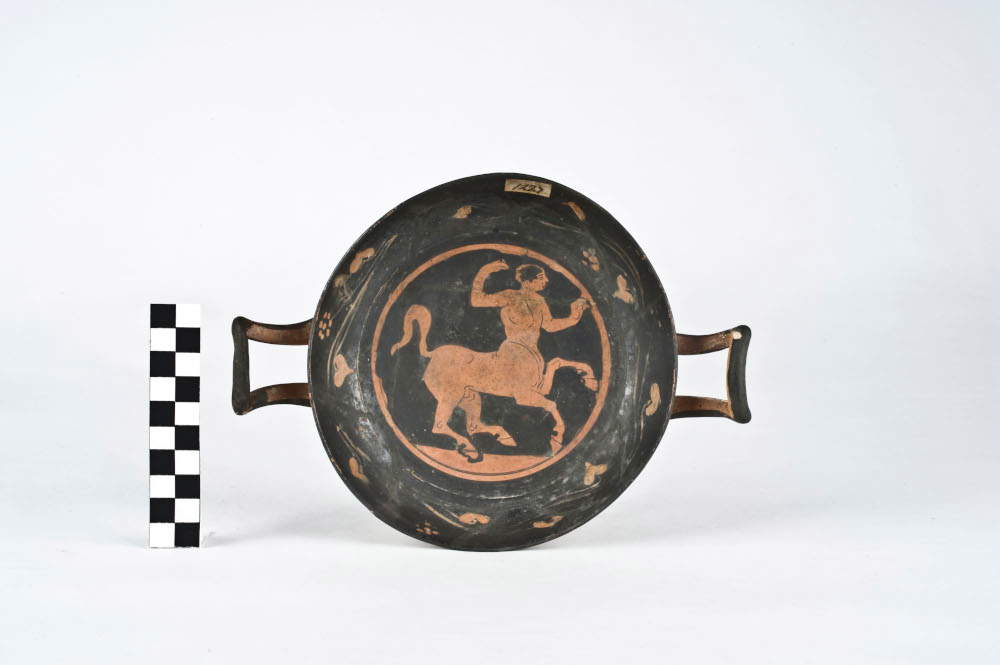
This very elaborate amphora preserved in the Jatta National Museum in Ruvo di Puglia is an Apulian panathenaic amphora with red figures. Panathenaic amphorae constituted the official prize of the Great Panathenae of Athens (sporting competitions held every four years dedicated to the goddess Athena) and were used to contain oil from sacred olive trees. Attributed to a ceramographer active between 335 and 345 B.C. in the Ruvo Group 423, the amphora was found in fragments and has been restored and painted over the entire surface. Two funeral ceremonies are depicted on the two sides, while along the lower register runs a continuous decoration with the sea procession of Nereids bearing weapons. The Nereids were, in Greek mythology, sea nymphs, daughters of Nereus and the Oceanina Doris, and here they accompany the deceased to their immortal sojourn in the Isle of the Blessed: thus, the beneaguring significance of survival from physical death should be attributed to them. The depiction refers to the episode in which, on the battlefield of Troy, Hector killed Patroclus, Achilles’ close friend; to the hero’s cries rushes his mother Thetis accompanied by the Nereids, who, in a marine procession, set out to bring Achilles the weapons made by the god Hephaestus with which to confront Hector and avenge their comrade’s death. Seated on a ketos or clinging to a dolphin, the Nereids are in fact depicted carrying unlined swords, helmet, shield and spear. The episode becomes a mythical paradigm of the theme of handing over weapons to a warrior leaving for battle.
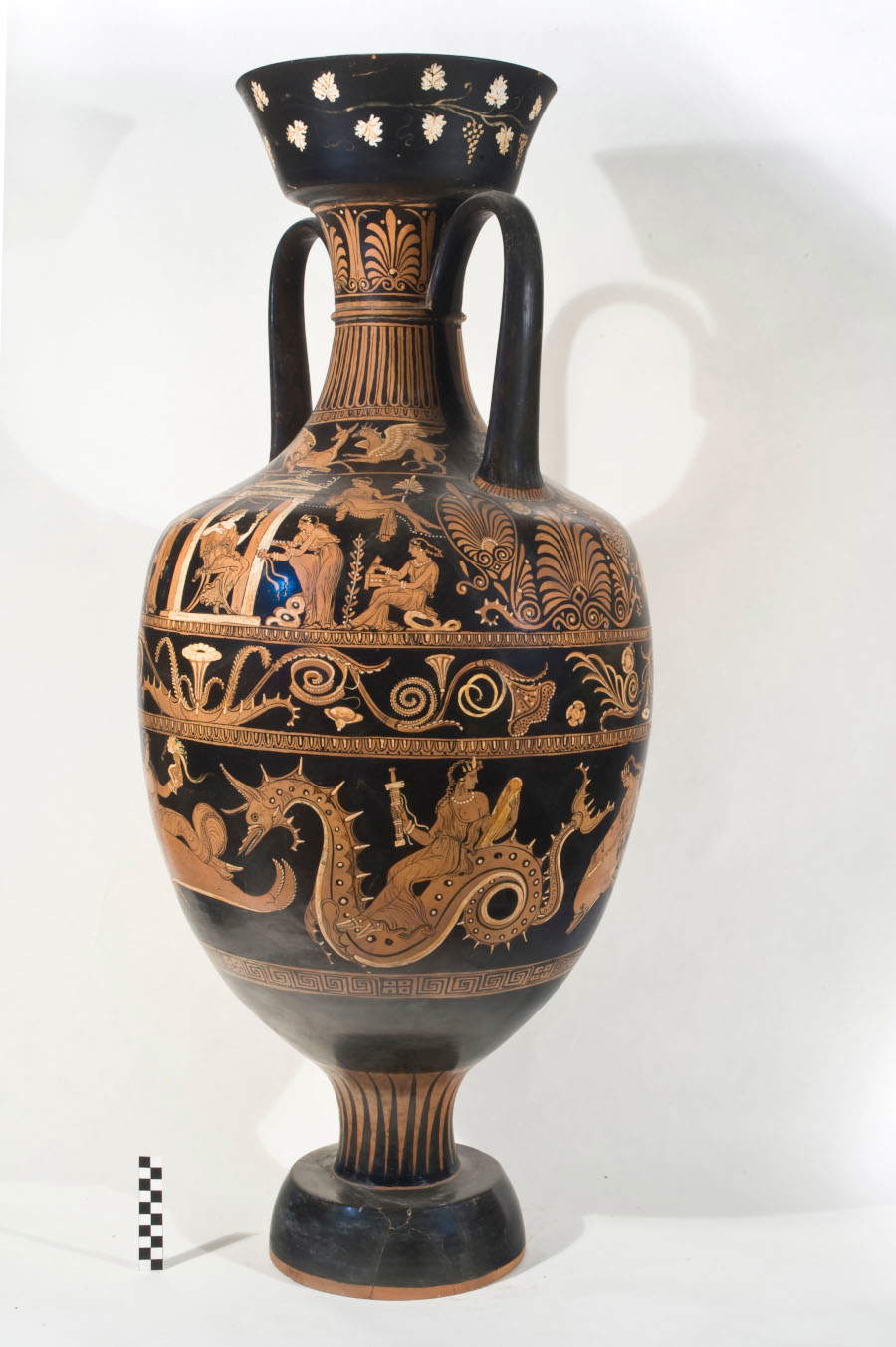
This silver-plated relief flask preserved at the National Archaeological Museum in Altamura dates from the fourth century B.C. and is part of the funerary equipment from the monumental tomb found during an excavation in Via Bari in 1974; an excavation that revealed about one hundred and fifty objects of Apulian ceramic wealth and quality. The flask was used for transporting small quantities of beverages; it has a flattened cylinder body with slightly inflated discs bordered by a protruding radial plastic appliqué. In the center, surrounded by an ovoli wreath, is a medallion with a relief image depicting two creatures from mythology: a chimera with a lion’s head and body, a second goat’s head on its back and a snake’s tail, and a triton or hippocampus, a sea animal half horse and half fish.
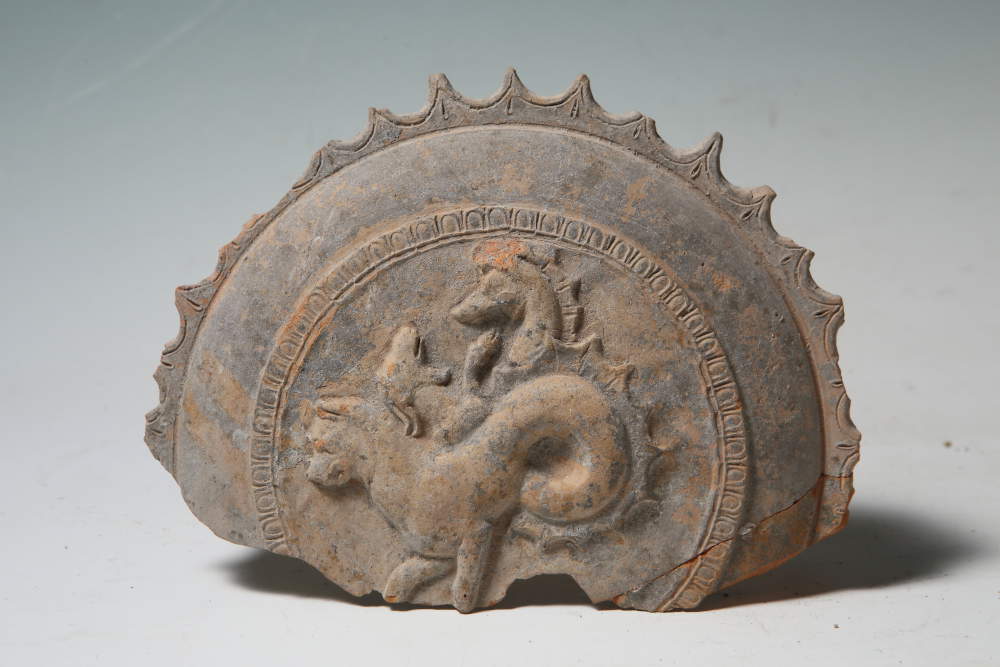
This black-figure crater preserved at the National Archaeological Museum in Gioia del Colle was found in 2002 in a tomb within a sacred building on Mount Sannace. Dating from the first half of the 6th century B.C., it is the work of an artist belonging to the middle phase of Corinthian vase production known as the Painter of Memnon, a name derived from one of the ceramographer’s three other known craters, the Berlin crater, on which Achilles and Memnon are depicted fighting. The main side of the Gioia del Colle crater depicts the finale of the contention between them: the episode taken from the Trojan War ends with the warrior of Ethiopian origin on the ground, struck dead in the duel with Achilles, who confronts and pierces him while partially covering himself with his shield. Also present are the respective divine mothers, Eos and Thetis, each descended from their chariots. On the other side of the vase is a choral dance in honor of the victor, while on the side is a monstrous animal with the head of a woman with long hair and the body of a bird, sometimes interpreted as a sphinx or as a siren or harpy.

This antefix with a Gorgon’s head was also found during an excavation on Mount Sannace, completed, however, in 2013. It was located inside an archaic building, in a room interpreted as a megaron, or the innermost and most sumptuous room of Mycenaean palaces. The terracotta antefix, made in Taranto, dates to the last thirty years of the 6th century B.C. and must have originally belonged to the decoration of the sloping part of the roof, probably with two pitches. Formerly painted in brown and red, it is semi-elliptical in shape and depicts a Gorgon’s head with large protruding almond-shaped eyes, sharp teeth like fangs, hair styled “a lumachelle” and pearly braids, and a beard with sharp locks. The Gorgons are monstrous creatures from Greek mythology: daughters of Phorcus and Ceto, they were three sisters, the most famous being Medusa, who had the ability to pity anyone who looked at them with their gaze. The function of these objects was originally to deter someone from entering a place through the use of fear: in this sense the gorgon was considered a protector of places and secrets.

At the MARTA - National Archaeological Museum in Taranto is preserved a balsamarium, or container that the ancients used for ointments and perfumed essences, with the likeness of Acheloo. The latter belongs to Greek mythology and is the river deity son of Ocean and Thetis, specifically the personification of today’s Aspropotamus, one of the longest rivers in Greece.
According to the myth, Acheloos was in a fight with Heracles because he wanted Deianira, the daughter of the king of the Aetolians, to marry him instead. During the fight, Acheloos turned first into a snake then into a bull, into a dragon and finally into a taurine-headed man; Heracles managed to snatch a horn from him (what would become the so-called cornucopia, filled with fruit and flowers and consecrated by the Naiads). It is also said that from the drops of blood from the wound the sirens would be generated.
The balsamarium dates from 580 to 570 B.C. and was found in Taranto, near the Military Arsenal, in 1914.
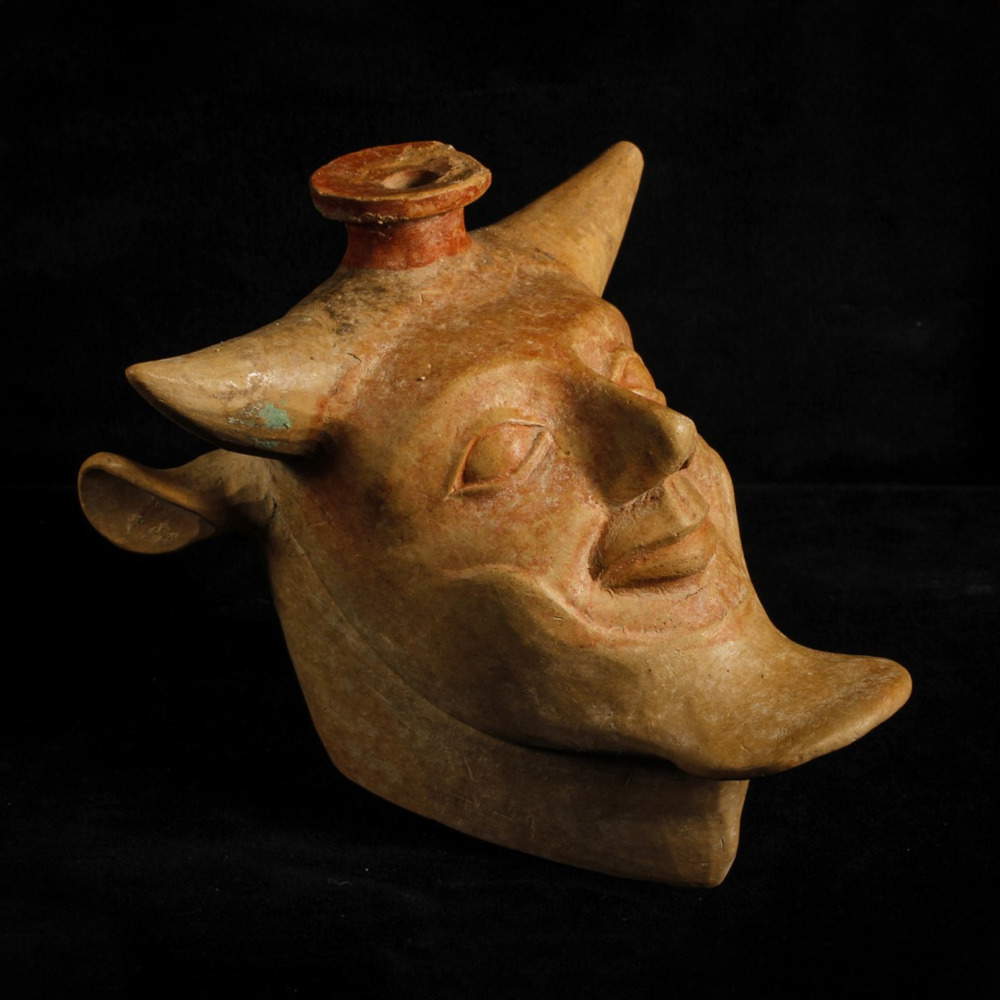
The Swabian Castle of Bari opened and reopened to the public in 2011, on the occasion of the 150th anniversary of the Unification of Italy, the Gipsoteca, which brings together in two rooms on the ground floor various casts taken from Puglia’s most famous monuments. In 1911, the Provincial Administration of Bari commissioned sculptors Pasquale Duretti and Mario Sabatelli to reproduce the sculptural details and ornamental motifs of Puglia’s most significant religious and civil monuments for the Regional Ethnographic Exhibition that was to be held in Rome’s Piazza d’Armi; these included those of the Cathedral of San Sabino and the Basilica of San Nicola di Bari. Once the Roman exhibition was over, the casts returned to Bari, and in 1949 they were placed in the Swabian Castle, where the Gipsoteca was opened to the public in 1957. In addition to religious subjects, there are also subjects from classical mythology and numerous depictions of animals and fantastic creatures, such as griffins and sphinxes. The former drawn from the apsidal window of the Cathedral fight a dragon and a serpent and are depicted as powerful and victorious; the sphinx on the prothyrum of the Basilica’s portal is shown proud, with a human face, lion body and bird wings, a symbol of strength and wisdom.
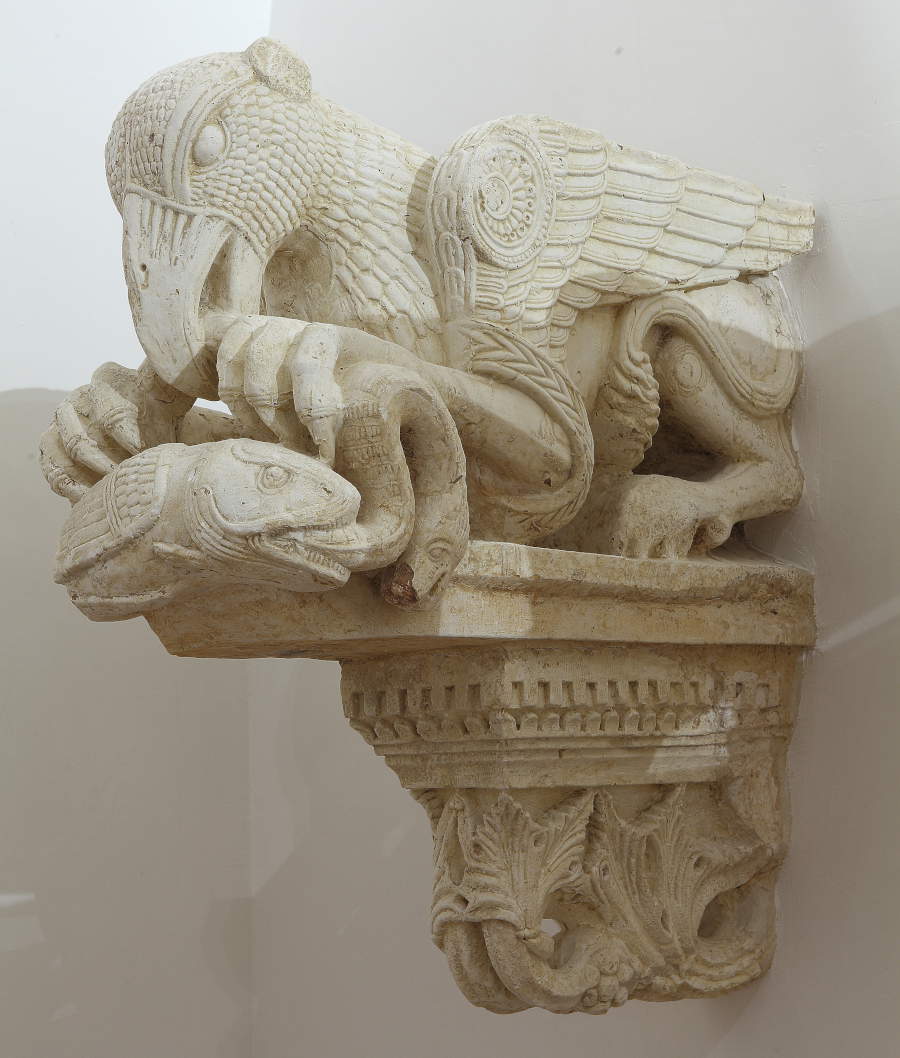
At Palazzo Sinesi, home of the National Archaeological Museum of Canosa di Puglia, it is possible to admire the furnishings of the Archaic tombs and rich Hellenistic hypogea in their entirety and variety, including those of the Varrese Hypogeum, one of the most important chamber tombs in Canosa. Belonging to the latter are polychrome and plastic vases called canosini decorated with tempera-painted images, mainly in pink. Of particular significance are two askoi, containers used in ancient Greece for pouring small quantities of oily liquids: one has the snake-bodied handle of a hybrid being with a male torso and two swan heads and is decorated on the front with a Gorgon and on the sides with two winged horses; the other has the pisciform-bodied handle of a hybrid being with a winged female torso and on the front a Gorgon is depicted, while on the sides hippocampi with volute wings and bifid fins are noted. The two askoi with polychrome decoration are dated to the end of the fourth century BCE.
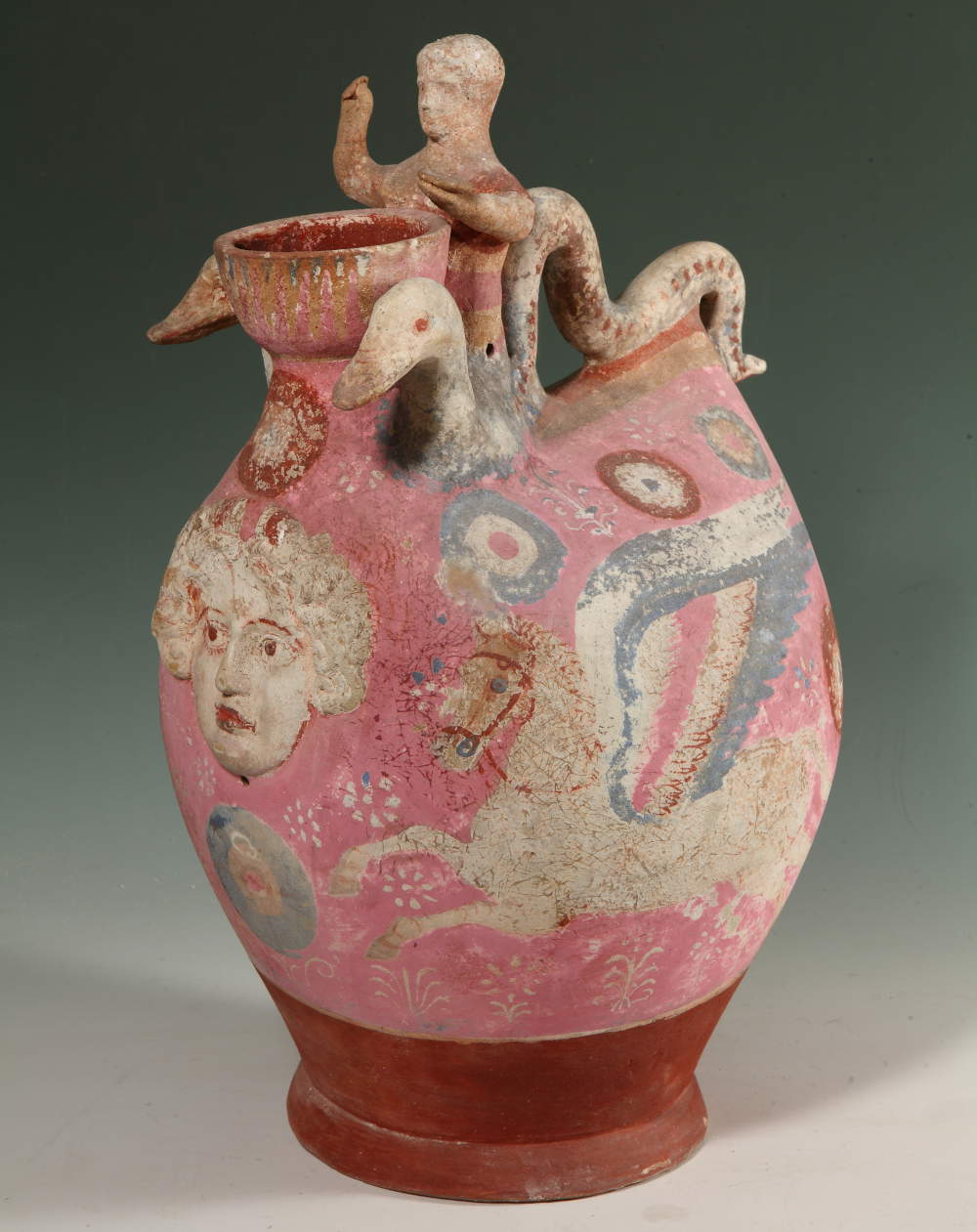
Castel del Monte has a sculptural decorative apparatus that includes figured keystones and corbels that refer to faces of fantastic creatures: bearded heads with thick hair and two goat ears identifiable as fauns or satyrs. The sculptural decoration is an integral part of the architecture and is indebted to ancient forms combined with Gothic forms, in line with the so-called fantastic Middle Ages defined by Raphael Licinius. Both the keystones and the figured corbels belong to the Cistercian figurative repertoire, which was inspired by nature, as seen in the grapes and the faun’s vines, and which unites the entire plastic ornamental apparatus of Castel del Monte. The figured corbels are located at the top of the second floor access towers and serve to support the upper architectural element. The figured corbel supporting the vault of the so-called Falconer’s Tower, on the other hand, is part of a trio that includes a donkey- or goat-eared man, a smiling woman with her head surrounded by a crown of leaves, and a third that has been lost.

This bronze satyr bust by the Molfettese artist Filippo Cifariello (Molfetta, 1864 - Naples, 1936) kept in the National Gallery of Apulia in Bitonto, also known as the “Girolamo and Rosaria Devanna” Gallery from the donation of the two brother collectors, is of uncertain dating but may refer to the last five years of the 19th century, a period in which the artist was very active, particularly to 1895, when he made more than seven hundred models for the porcelain factory in Passau, Bavaria. The satyr is the mythological personification of fertility and the life force of nature, linked to the Dionysian cult. Deliberately rough-hewn and unpolished, the surface of the sculpture reinforces the rendering of the mythological creature, highlighting the wrinkled face, the cunning grin, and the viscous gaze. It is an artifact of singular vitality, characterized by a quick and nervous technique, a vital energy that flows from the folds, ripples and active, participating eyes.
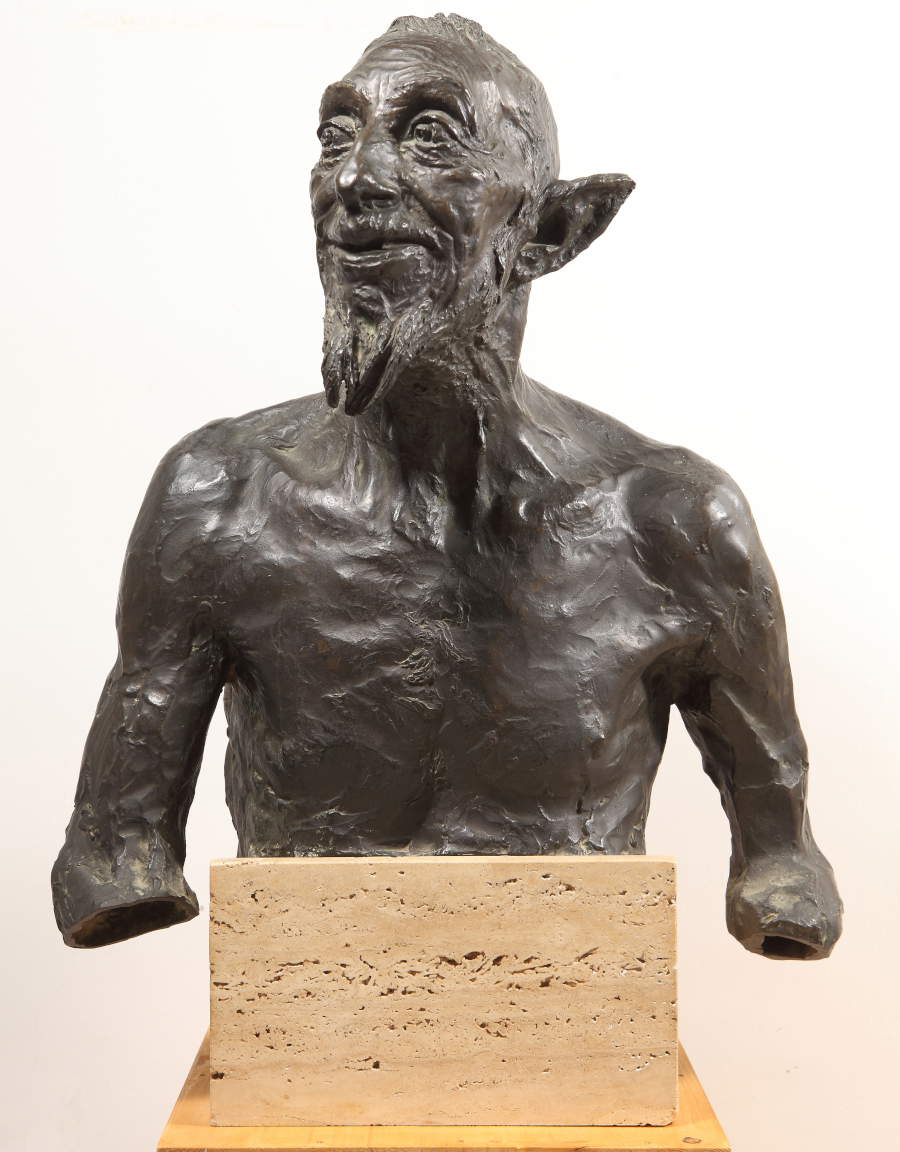
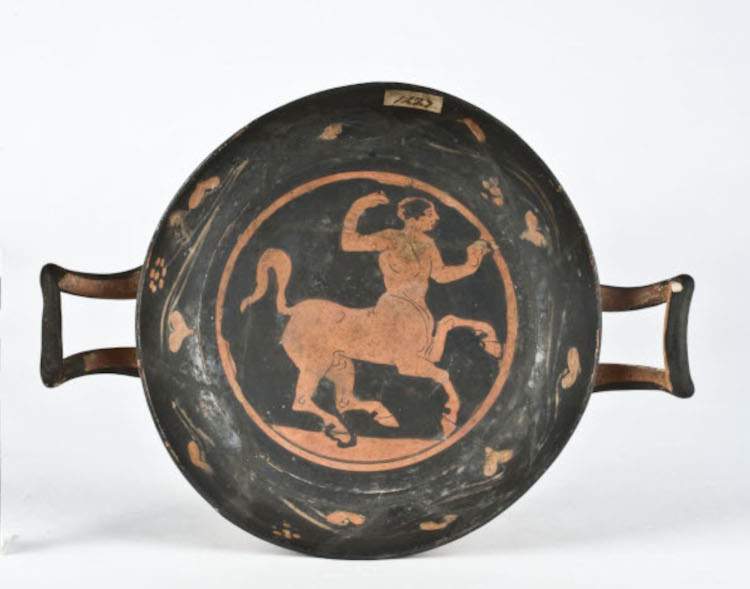 |
| Animals and fantastic places in Italy's museums: Puglia |
Warning: the translation into English of the original Italian article was created using automatic tools. We undertake to review all articles, but we do not guarantee the total absence of inaccuracies in the translation due to the program. You can find the original by clicking on the ITA button. If you find any mistake,please contact us.